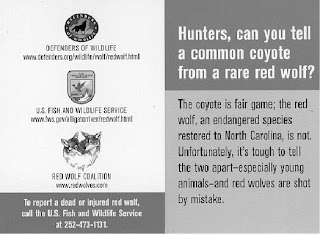 In my first post about red wolves, I discussed the physical and genetic similarities that coyotes and red wolves share. I also showed pictures of both species as a comparison. These two animals are very difficult to tell apart, especially if it is from a distance while one runs through the grass or across the road. Although each species has their own specific body dimensions such as height, length of the legs and snout, and the degree of bushiness in the tail, these differences would not be obvious to the untrained eye.
In my first post about red wolves, I discussed the physical and genetic similarities that coyotes and red wolves share. I also showed pictures of both species as a comparison. These two animals are very difficult to tell apart, especially if it is from a distance while one runs through the grass or across the road. Although each species has their own specific body dimensions such as height, length of the legs and snout, and the degree of bushiness in the tail, these differences would not be obvious to the untrained eye.
In an effort to curb this growing problem, the U.S. Fish and Wildlife Service made a pocket-sized card to help educate hunters on the differences of the two species. The card also asks hunters not to shoot east of Highway 32, where the entire population of red wolves (and the lowest population of coyotes) resides. These cards are now given to people when they get a hunter’s license. Hopefully this, along with other local education measures, will help to cut down on the amount of red wolves that are lost each year to gunshot.
Both canid photos above are red wolves, but can easily be mistaken for coyotes when they are seen from long distances or moving quickly.
“Red Wolf on Pungo Road” photo courtesy of Mike Dunn.


